Making pie crust for the first time might seem scary, but it doesn’t have to be. I learned how to make from-scratch pie crust the old fashioned way– the really old fashioned way– by studying vintage and antique cookbooks. Over time I learned how to make a flavorful, flaky pie crust from scratch. With a little patience and a bit of practice, you too can make an old fashioned all-butter pie crust.
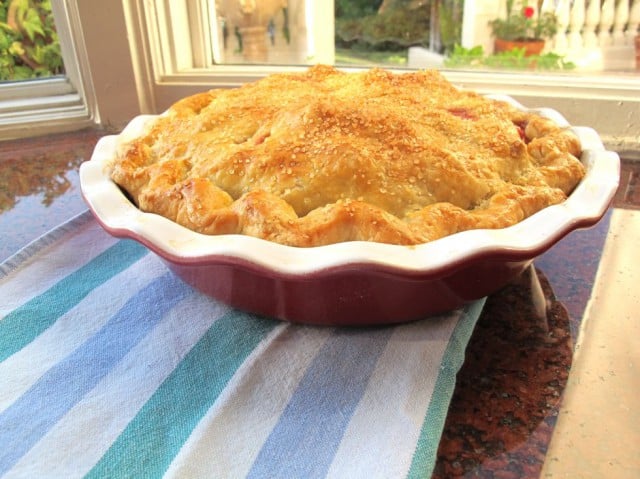
Vintage volumes like “Pie Marches On” by Monroe Boston Strause (1939), “Good Housekeeping’s Party Pie Book” (1958) and “250 Superb Pies and Pastries” by Ruth Berolzheimer (1950) taught me the basics—fat to flour ratios, how to roll out the crust, how to elegantly flute or scallop the edges. Modern cookbooks like Bubby’s Homemade Pies (2005) and Mrs. Rowe’s Little Book of Southern Pies (2009) gave me updated pointers, like how to use the refrigerator and freezer to keep your fat cold as you assemble your dough (refrigerators were a relatively new invention in 1939).
For the best pie advice of all, I have to give credit to Aunt Chick. A small, thin paperback volume from 1942 by Nettie McBirney, titled “Aunt Chick’s Pies,” really gave me a solid foundation for crust making.
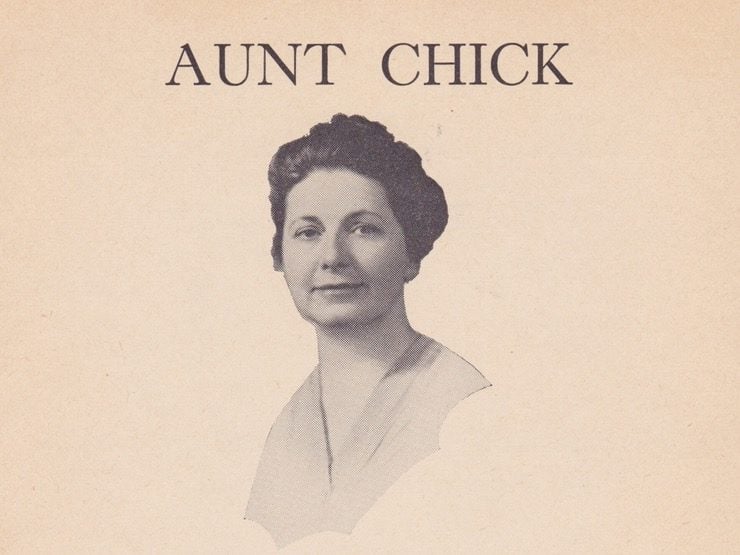
“Aunt Chick’s Pies” is an unassuming little volume– a simple red paperback with no picture on the cover. It was published in Tulsa, Oklahoma. I picked it up at a flea market one Sunday afternoon from a box of old cookbooks. I never learned to make pie crust from scratch growing up; it was one of those cooking techniques that always made me nervous. It seemed really hard. I bought “Aunt Chick’s Pies” because the smiling woman on the first page gave me confidence. She seemed wise, secure, self-assured… she knew the secrets of a great pie crust, I just knew it. So I brought it home and started teaching myself to make pie crust.
And guess what? Pie crust is not as difficult as it seems. Really! And it gets a LOT easier with practice.
Most pie crusts are made by combining flour and water with shortening, butter, lard, or any combination of those fats. Me? I prefer butter… plain, simple butter, the most delicious of fats. It’s not easy to work with—in fact, it’s probably the most finicky of fats—but the flakiness and flavor that results from an all-butter crust is out of this world. It’s worth the fuss.
For kosher cooks, butter crusts are not ideal because they can’t be served with a meat meal. In a future blog I will talk about how to achieve a tasty pareve crust using dairy-free shortening. But today, it’s all about the butter.
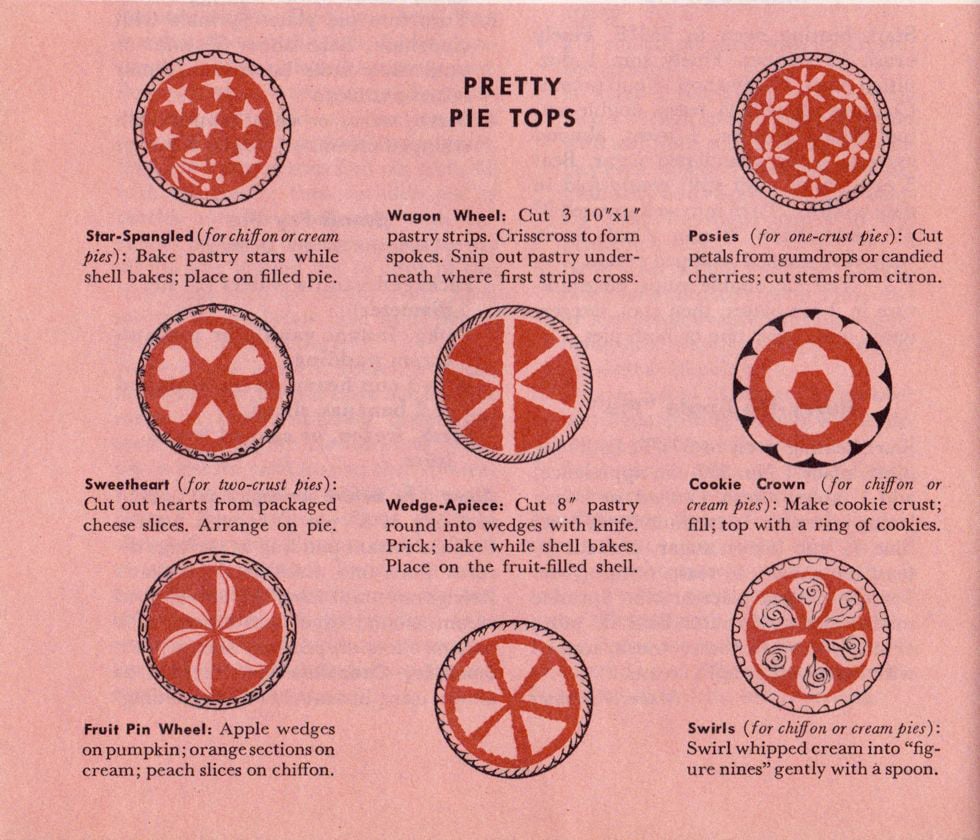
I originally found the ratio for my all-butter pie crust in Aunt Chick’s Pies—3 cups flour, 1 cup fat, 2 tsp salt, ½ cup liquid. This combination makes enough dough for a deep dish double crusted 9 inch pie. The ratio actually works for any fat, whether you’re using shortening, lard, butter, or any combination of the three (obviously you wouldn’t want to use a combination of lard and butter if you’re keeping kosher!). The ratio has provided me consistently good results, and I’ve made many lovely and scrumptious pies using it. If you prefer a less salty crust, cut the salt in the recipe to 1 tsp. I think a little saltiness plays nicely with a sweet pie filling.
There are many ways to assemble a double-crust pie… you can lattice the top, decorate it with crust shapes, or make a wagon wheel design (illustration above). If this is your first time making pie crust, I recommend following the steps on this blog till you’re comfortable making a simple double-crusted pie. Creating lattices and other techniques can be tricky, but fun… I’ll cover those kinds of design techniques in a future post!
The pie I made for this blog is a Strawberry Rhubarb Pie, an old fashioned summer favorite. To learn a bit about the history of pie in America, click here.
Pie crust is one of those things that can leave a new cook frustrated. It takes time and practice to get the method right. Repetition is key… the more you make it, the better you’ll understand it. I’ve posted lots of pictures in this blog and very clear steps to keep you on track. For those of you who are worried about messing up, I leave you with a few words of wisdom from Aunt Chick herself—
Don’t be scared. It is just pie crust.
Recommended Products:
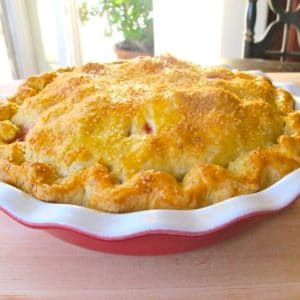
Old Fashioned All-Butter Pie Crust
Ingredients
- 1/2 cup cold water
- 4 ice cubes
- 3 cups all-purpose flour
- 2 teaspoons salt
- 1 cup very cold unsalted butter (2 sticks)
NOTES
Instructions
- Pour cold water into a small dish with a few pieces of ice to chill.

- There are two ways to integrate the butter into the dry ingredients… by hand mixing or with a food processor. In my experience, both methods work equally well as long as you mix the water in by hand. Don't process the water into the dough, or you'll end up with a tough crust.BREAK UP BUTTER BY HAND: Add flour and salt to a large mixing bowl, stir with a fork to blend. Take cold butter out of the refrigerator and add it to the bowl. Use a pastry cutter to cut the cold butter into the flour, using firm pressure and pushing down repeatedly to break the butter into small pieces.

- Work as quickly as you comfortably can. Stop when the flour and butter mixture looks like large-curd cottage cheese. There should be a variety of sizes in the butter pieces… the largest should be about the size of a pea. Place flour and butter mixture in the freezer for 2 minutes before proceeding.

- MIXING DOUGH WITH FOOD PROCESSOR: Fit your processor with a blade attachment. Add flour and salt to the food processor.Take cold butter out of the refrigerator and add it to the processor.

- Pulse the processor in 3-second bursts to break up the butter. Stop when the flour and butter mixture looks like large-curd cottage cheese.

- There should be a variety of sizes in the butter pieces… the largest should be about the size of a pea. It should only take 10-12 pulses to get the right consistency; start checking consistency after 8 pulses. Make sure you don’t over-process… having a variety of sizes in the butter chunks will make a flakier dough. Mixture should hold together when squeezed in your hand. Pour mixture into a mixing bowl. Place flour and butter mixture in the freezer for 2 minutes before proceeding.

- Take ice water out of the refrigerator. Add water to the flour mixture one tablespoonful at a time, using a fork to lightly toss the liquid into the dough. Try not to touch the dough as you mix; you want the mixture to stay as cool as possible. You may not need all the liquid to bring the dough together, so add slowly… the dough can easily turn wet and sticky if you’re not careful. By the same token, you may need a bit more liquid. Pie dough is not an exact science; every batch of dough will be different.

- When the dough begins to look stringy and larger lumps begin to form, take a fistful of the dough and squeeze it in your palm. Open your palm. If the dough holds together well and is just slightly tacky, it’s ready to pull into a dough ball. If the dough easily crumbles in your hand or falls apart, it is still too dry… add a little more liquid.When dough is ready, pull it together with your hands into two balls, one slightly larger than the other. Flatten the balls into disks that are 7-8 inches across.

- Cover the disks tightly in plastic wrap and place in the refrigerator immediately.The dough should be refrigerated for at least 1 hour, and up to 48 hours. I prefer to make the dough a day ahead and refrigerate it overnight. You can also freeze the dough for up to 3 months. If you freeze the dough, allow it to thaw and soften a bit before rolling out.

- TO ROLL OUT CRUSTS: Any large, smooth surface will work, as long as it is in a cool dry area. Marble is ideal. You will need to work quickly to roll out the dough– again, you want it to stay cool, so have any tools you need nearby and ready to go: rolling pin, flour, pastry scraper, 9” pie plate or dish, a sharp knife, and a baking sheet (as needed).Lightly flour your rolling surface. Take the larger of the two dough disks out of the refrigerator and discard the plastic wrap. Place it in the center of your rolling surface and sprinkle the top of the disk lightly with flour.Use your rolling pin to roll out the dough. I like to roll it from the center outward, a roll in each direction, as though I’m rolling around the face of a clock (12, 3, 6, 9, 12). You want the dough to expand evenly in all directions, so that it forms a large circular shape. Use more pressure in the center of the dough, and less as you near the edges. Don’t roll past the edge of the dough.

- As you roll, you may notice cracks forming on the outer edges. If any large cracks develop, pause and pinch the dough together to mend them before rolling again.

- If the dough becomes sticky as you roll, lightly re-flour the surface of the dough before proceeding. When the dough is about halfway rolled out, use a pastry scraper to loosen the dough from the board and flip it over.

- Re-flour the board before positioning the dough in the center again. Continue to roll out the dough in the same way as before.You want the dough to end up about 1/8” thick, and as round as possible. As you roll it out, you should see a marbled effect to the dough where patches of butter have formed. This is a good thing—those pockets of butter are what make the crust flaky.

- Rolling out pie dough swiftly and efficiently takes practice. You may find that your dough is getting too soft, or the butter pieces are melting, as you roll. A little stickiness can be remedied by a sprinkle of flour, but if the dough is getting warm or the fat is melting you’ll need to re-chill the dough before proceeding. Use the pastry scraper to loosen the dough from the board and place it on a baking sheet. Place the baking sheet in the freezer for 1-2 minutes to re-chill the dough. Continue rolling out.When the dough is about 1/8” thick all the way around, take your pie dish or plate and center it in the middle of the dough. The dough will need to extend about 2 inches past the edge of the dish. Use a sharp knife to cut any rough edges off to form a smooth 2-inch circle around the outer edge of the pie dish.Unfold the dough and let it gently settle into the pie dish, lifting the edges of the dough and letting gravity pull it down into the corners. Do not stretch the dough to fit the plate; let it settle naturally, or you’ll end up with a leaky bottom crust. Adjust the dough as needed to keep it as centered as possible in the dish.Alternatively, you can transfer the crust to the dish by rolling it around the rolling pin and unrolling it over the pie dish. I prefer folding it, since it’s easier for me to center in the dish that way, but either method works.When the pie dish has been lined with dough, place it in the refrigerator to chill.Take the smaller of the two dough disks out of the refrigerator and roll it out the same way as you did the first. When trimming the edges, the dough only needs to extend about 1 inch beyond the edge of the pie dish. Re-chill on the baking sheet after rolling out, if necessary. This will be your top crust.Assemble your pie by filling the lower crust with your filling, dot the filling with butter, if the recipe requires it, then lay the top crust gently over the top of the pie. Center the top crust as much as possible over the top of the dish.Trim the edges of both crusts so that they are a little less than 1/2 inch beyond the rim of the pie dish.Roll the lower crust over the top of the upper crust and pinch gently to form a lip or edge to the crust. Work your way around the pie, rolling and pinching, until the circle is completed.Finish your edges by scalloping or crimping them with a fork. I like to scallop the crust by using the forefinger of one hand to make a crease, then pinching around the crease with the thumb and forefinger of the other hand.I work my way around the inner edge of the pie first making creases, then I finish it by working around the outer edge, scalloping in the opposite direction.Chill the fully assembled pie for at least 10 minutes before baking. Make an egg or milk wash and brush on the upper crust for a nicely browned finish (optional). Milk washes can be a bit uneven, so I prefer an egg wash– use an egg yolk whisked together with 1 tsp of water. This will give it a nice golden sheen.Cut slits in the upper crust to vent (after the wash, not before), and sprinkle the top of the pie with sugar, if desired. I sometimes like to sprinkle it with turbinado sugar to add a light candy-like crunch and a little sparkle.Bake pie according to recipe directions. During the baking process, I usually turn the pie 180 degrees about halfway through the cooking time to make sure the crust browns evenly (ovens can be hotter in the back than in the front– this allows for more even heat distribution).If these instructions are followed carefully, you should end up with a flavorful, flaky pie crust! Happy baking. 🙂

Nutrition

tried this recipe?
Let us know in the comments!
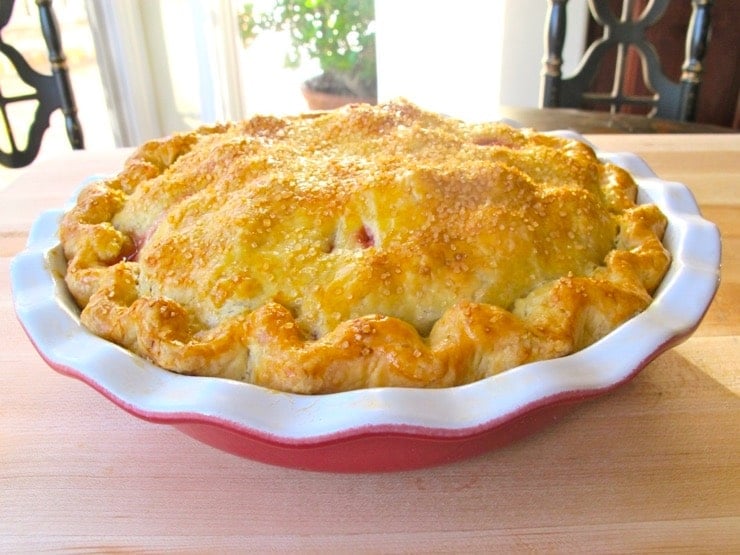
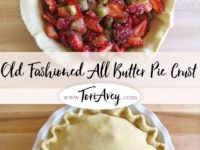
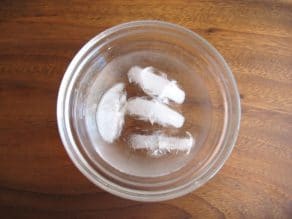
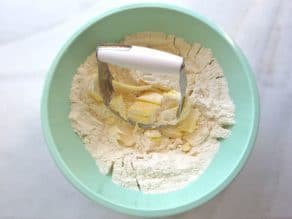
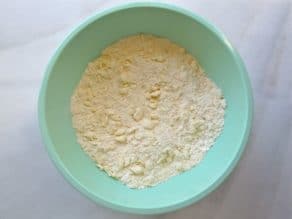
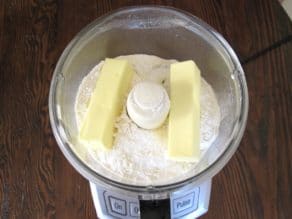
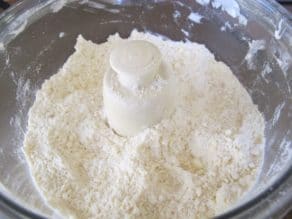
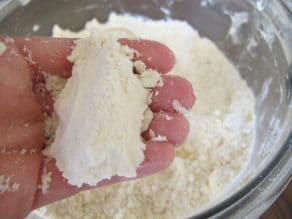
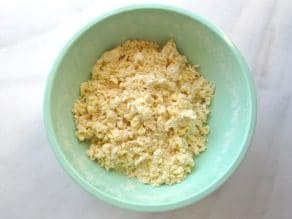
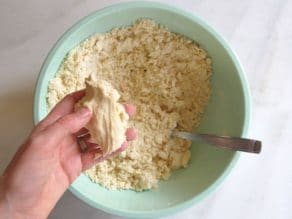
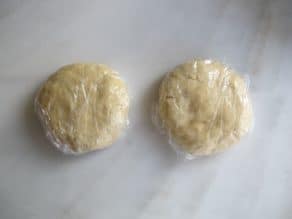
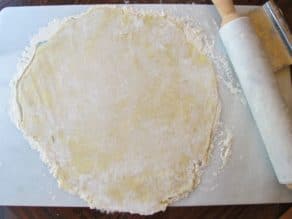
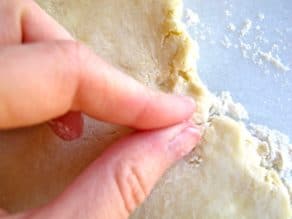
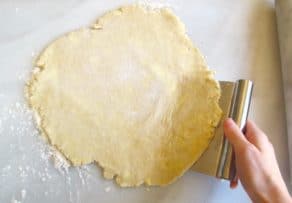
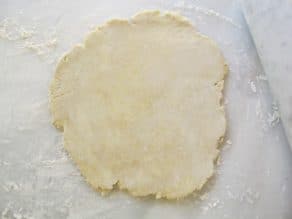
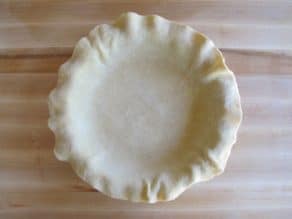


I’ve never made a pie crust before but you’ve inspired me to try. Can I use stick margarine or Crisco instead of butter to make the crust pareve? If so, which one do you think would work better? Love your blogs!
Hi Jill! You certainly can. I recommend subbing Earth Balance vegan buttery sticks, it’s the best non-dairy baking substitute I’ve found so far and it gives a nice buttery flavor. It does contain salt, so I would cut the added salt in the dough back to 1 1/4 tsp. You can also use shortening, if you prefer, or a combination of both Earth Balance and shortening. Shortening is very easy to work with in terms of crust, it won’t melt as fast as butter or margarine. Just be sure the total amount of fat equals 1 cup, and the fat is well chilled before incorporating into the dough. Good luck!
First let me say thank you for making it look easy. Before I hopped online I must confess, I called my mother and asked her what her secret was for a great pie crust. (I’ve asked half a dozen times) I have to admit pie crust and I have not been the best of friends and I’ve been told it just practice, practice, practice… Having said all that, after seeking the good advice of my sweet mother (who can bake anything under the sun with her eyes closed) I opted to try your recipe. I doubled the recipe and used half butter half shortening…I’ve got two double crusted chicken pot pies as I type in the oven…All four kids are anxiously waiting….thanks again..
So happy to hear that CeCe! Bet your house smells delish right now…
Haven’t tried this pie crust, but will try it soon. Thank you
for the detailed info. Excellent illustrations, enjoy your blog.
I have a very simple recipe. Have never been successful with
most pie crusts, I tend to over-work the mixture. With this recipe however the vinegar does something. My husband the
chemist says it’s the vinegar interacting with the other ingredients. It’s a fail safe recipe. And very easy to make.
Here it is. Thanks Elizabeth
Perfect Pie Crust-made with Vinegar
(Best and easy to make)
3 cups flour
1 tsp. Salt
1 -1/4 cup shortening (Use that yellow shortening
that looks like butter)
1- egg beaten
1 TBS. White vinegar
4 TBS. Cold water
Stir salt and flour together.
Cut in shortening.
Add liquid ingredients.
Mix but don’t over work the mixture.
Enjoy!
Thanks for sharing Elizabeth! I’ve been known to add a bit of vodka to my crusts, it does improve the texture somewhat… probably the same principle behind the vinegar!
I just baked my first-ever pie tonight, and curiosity about making the crust with butter instead of hydrogenated shortening led me to your site. I haven’t tried the pie yet, but the leftover crust turned out to be amazing. Thank-you for posting this.
I do have a question, though. What’s the difference using unsalted butter then adding salt and just using salted butter?
Ethan, using unsalted butter allows you more control over the amount of salt going into the crust. I always start with unsalted butter, then I know exactly how much salt will be going into my recipe (since the saltiness of different butters may vary).
how do I get to the tutorial on this recipe?
thanks.
Hi Donna, the step-by-step photo tutorial should be visible above. Let me know if you can’t see it.
Hi, I have two questions for you – how long would you cook a plain pie crust you wanted to bake alone, to fill with something like lemon meringue filling? And then it has a second bake for the meringue -what’s your recommendation for the best way to do this? Thanks s much and cheers, Mia
No problem at all, I thought the problem with the text not loading was on my end. I love the photos, love the pie, love the crust, love the blog – and it should have been pretty evident “where the water goes.” Duh….into the bowl with the pie crust mix, perhaps? Too many days with too little sleep lately. Thanks so much for helping me fill in the blanks with your fantastic site! I’m baking that pie tomorrow… Cheers, Mia
I’m at a loss because I can only see photos and no words…so I don’t know what you did with the ice water and cubes, you show them in a bowl but then I can’t see what you did with it…put it into the flour and butter, or used it to keep the butter cold etc.? Is there someplace I can get the instructions that go with the photos? Thanks<:}
Hi Mia! I’m so sorry, I’m not sure what happened to the instructions… I will need to have my web guys take a look at this. I’ll let them know right away. Thanks for pointing it out!
I always learn some little thing new from you, thanks, I like the roll to the inside on the top crust, I have always tucked and crimped. Nice clean idea from you!
I finally made your crust. Wonderful! I used goat butter without any problem. I never knew the trick to not using wax paper to roll out the dough, but thanks to your directions I managed. Thank you! Also I really love the rolling of the two crusts to seal them together to make a beautiful presentation. Thank you so much for fabulous instructions!
Can anyone tell me what happens as you increase the butter to flour ratio in the crust? As I mentioned, I accidentally used half the flour called for in my first pie. I was happy with the results, but don’t know if the crust gets flakier with more flour.
I added just 1/2 cup more flour in my second pie, making it 2 cups flour to 1 cup butter, since I was going to run out of dough. The crust was still wonderful.
I also love this recipe because despite all of the juicy peaches, the crust never got soggy. Thanks again! Butter is *The* way to go.
I have been trying to find the perfect Pie crust for a awhile now. I think I finally found it!! I just made a Raisin Pie and used this recipe for the crust and I’m very impressed! Thanks so much!!
My first pie! I followed your recipe, and, after being thoroughly impressed with my uncharacteristic patience through all of the steps- realized that I had measured the flour with a 1/2 cup instead of a full cup.
However, I am thrilled I made the mistake. The crust is amazing. When I make it next, I will use 3 sticks of butter to 3 cups flour.
Thanks for giving me the courage! Here’s to good mistakes.
I’ve been wanting to make a pie forever but have been afraid like everyone else!! I found your recipe and decided to make it today–an apple pie–and… IT. IS. AWESOME!!! The innards I’ll have to play with, but the crust is better than I could have hoped for (next to my gramma’s of course). Thank you so much for all the research you did behind this recipe-I’m looking forward to doing my own reading up on Aunt Chick:) Happy cooking~Heather
I have found that grating frozen butter in my food processor works wonderfully. I grate it and put it back in the freezer until I’m ready to make my dough. Don’t simply use cold butter from the fridge – or you’ll end up with strips of butter like shredded cheese. It needs to be frozen. — If you’re an adroit processor manipulator, you can vary the pressure on the “plunger” as you press the butter into the blades, getting pieces that range from “snow” to “sleet” to “hail”! But uniform-sized bits of butter work just fine, too.
Great tip Melly, thanks!
I was at the end of my rope and I searched for “messed up pie crust” and thank goodness your site came up! I have just finished making this recipe and I can already see the difference. Thank you so much for posting this with the great pictures so I could see what I was doing wrong. Too much fat (crisco).
So happy I could help May! 🙂
I am always up for a new pie crust recipe. I always have used shortening as I was taught by my grandmother. I will be trying this recipe though, as I am a fan of keeping things simple and using as many unprocessed ingredients as possible.
I saw that there was a question regarding soggy bottom pie crusts. I always blind bake my pie crust at least for 10 mins covered in parchment paper weighed down with uncooked rice. I then pull the parchment and rice out and apply a light egg wash onto the pie crust and bake another 5 mins uncovered. The egg wash produces a layer that stops the filling from making the crust soggy. Also, make sure you let the pie crust cool to room temperature completely before using. I have never made a double crust pie using this method. If I want crust on top, I use the lattice technique and tuck the edges down the inside of the crust pressing the raw dough to the par baked crust. It works well for me. Just thought I would share my little tip.
Also, thank you for such a wonderful blog. I am so glad I found it.
Great tips Rachel. Thanks for sharing!
Never made a pie in my life, but there is a fair coming up and on a whim I entered the pie baking (entry fees go to a good cause). Everyone told me pies were easy but the crust was really hard, and an all butter crust was the hardest – especially for someone that never done it….well I made my first practice pie tonight and followed your crust directions to a T …..simple and absolutely delicious!!! My blueberry filling was ok, but your crust – aces, lady.
Now, I’m a fat ole fashion southern country boy –
And I’ve had a pie or two made by the finest
blue haired old women in the world…..so I’m a fair judge!!
Thanks for help – I need all I can get
Lincoln, your comment made me smile from ear to ear. 🙂
Hi Tori, I love looking at your blog, this pie looks brilliant. We are having really windy weather in England and all the apples are falling from the trees, so I’m going to try a rhubarb and apple pie. Thanks, Di
That sounds just lovely– apples and rhubarb, what a wonderful seasonal combination!
I have never made a successful pie crust and I have always felt so intimidated by them. (That’s quite a sentence of absolutes.) Thank you for this wonderful tutorial; it gives me courage to try again. I think I need to add ‘make a successful pie crust’ to my bucket list.